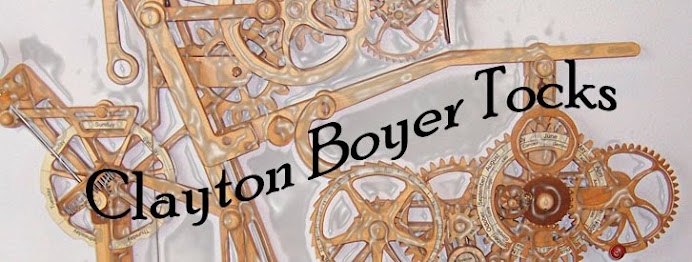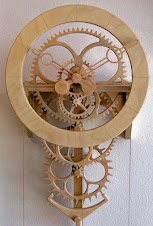 |
| Model T by Tony Cameron |
Tony: "Hello Clayton,
Having completed my version of your Model T, I am inspired by you and your designs. This is my second wooden gear clock, my first one from Fine Woodworking about 20 years ago (which my first wife has).
I would think I am not the first to lose a clock to a wife.
The Model T was a delight to build. The frame is from Tasmanian Myrtle, and the gears are from ply I made by laminating 1.6mm bending ply. The bending ply has 3 laminations of Hoop Pine, so I laminated 6 pieces of ply and then veneered both sides with Queensland Walnut ( 20 laminations in 12mm ply should be stable). The weight is lead poured in a metal pipe, which is in a sleeve of Queensland Walnut.
I finished the clock with 3 fine coats of Kunos Oil.
The Model T has been working constantly now for a month, and I am pleased by the kinetic sculpture’s accuracy. It is lovely to come home and hear the ticking.
If you consider my woodworking ability satisfactory, I would appreciate it if you would send me the link to ordering plans for your Radiance. I am amazed at a how a one wheel, no gear clock can work. So am I stupid, or perhaps I love the challenge it presents?
Clayton, the builders of your designs have the easy part, you and your creations are amazing.
Many thanks, Tony Cameron"
Clayton: "Wow, Tony, those wheels look good enough to eat! They look like chocolate. Yes, 20 lams in 12mm is amazing. My Baltic birch ply has only about half that many.
I joke about how inaccurate these clocks are - only because I don't want anyone getting stuck on the accruacy part - but they truly can be amazingly accurate, easily to one minute a day.
It's also nice to hear that you like her unusual song. I love that 'ticking' sound that she makes, too. So unusual, and very pleasant.
Your submission more than qualifies for your entry into the Masochist's Club. Welcome, Tony, to that cadre of elite wooden clock builders that make up the Masochist's Club. It is a pleasure to admit such a craftsman as a new member into this exclusive club.
Your Model T is a beauty.
Enjoy.
Aloha. Clayton"













